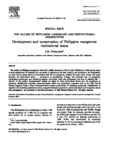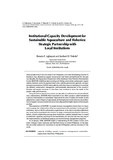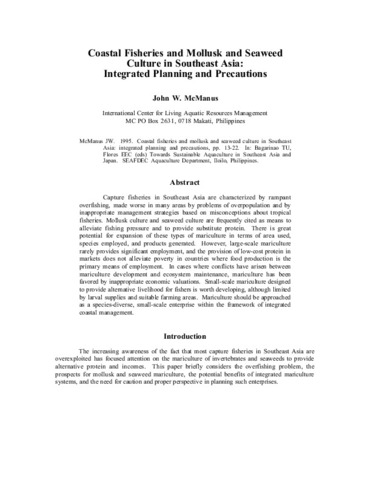Development and conservation of Philippine mangroves: institutional issues

View/
Request this document
Date
2000Author
Page views
247Metadata
Show full item recordCited times in Scopus
Share
Abstract
The decline of Philippine mangroves from half a million hectares in 1918 to only 120 000 ha in 1994 may be traced to local exploitation for fuelwood and conversion to agriculture, salt beds, industry and settlements. But brackishwater pond culture, whose history is intertwined with that of mangroves, remains the major cause of loss. The paper discusses the institutional issues — aquaculture as development strategy, low economic rent of mangroves, overlapping bureaucracy and conflicting policies, corruption, weak law enforcement and lack of political will — relevant to this decline. Recommended policies are based on these institutional factors and the experiences in mangrove rehabilitation including community-based efforts and government programs such as the 1984 Central Visayas Regional Project. These recommendations include conservation of remaining mangroves, rehabilitation of degraded sites including abandoned ponds, mangrove-friendly aquaculture, community-based and integrated coastal area management, and provision of tenurial instruments.
Description
Special Issue: The Value of Wetlands: Landscape and Institutional Perspective.
Keywords
Aquaculture Brackishwater ponds Community-based management Integrated coastal area/zone management Tenurial/property rightsSuggested Citation
Primavera, J. (2000). Development and conservation of Philippine mangroves: institutional issues. Ecological Economics , 35(1), 91-106. https://doi.org/10.1016/S0921-8009(00)00170-1
Subject
Collections
- AQD Journal Articles [1222]
Related items
Showing items related by title, author, creator and subject.
-
Resource Enhancement
Nasuchol, Nopparat (Training Department, Southeast Asian Fisheries Development Center, 2007)Presented in the paper are the resource enhancement activities that were undertaken at the Pathiew Distirc, Chumphon Province, Thailand. The activities were the establishment of artificial reefs, releasing of fingerlings, ... -
Institutional capacity development for sustainable aquaculture and fisheries: Strategic partnership with local institutions
Agbayani, Renato F.; Toledo, Joebert D. (Terrapub, 2008)Many people living in the rural areas in the Philippines, as in other developing countries in Southeast Asia, depend on aquatic resources for their food and livelihood. For the past two decades, the Aquaculture Department ... -
Coastal fisheries and mollusk and seaweed culture in Southeast Asia: Integrated planning and precautions
McManus, John W. (Aquaculture Department, Southeast Asian Fisheries Development Center, 1995)Capture fisheries in Southeast Asia are characterized by rampant overfishing, made worse in many areas by problems of overpopulation and by inappropriate management strategies based on misconceptions about tropical fisheries. ...




